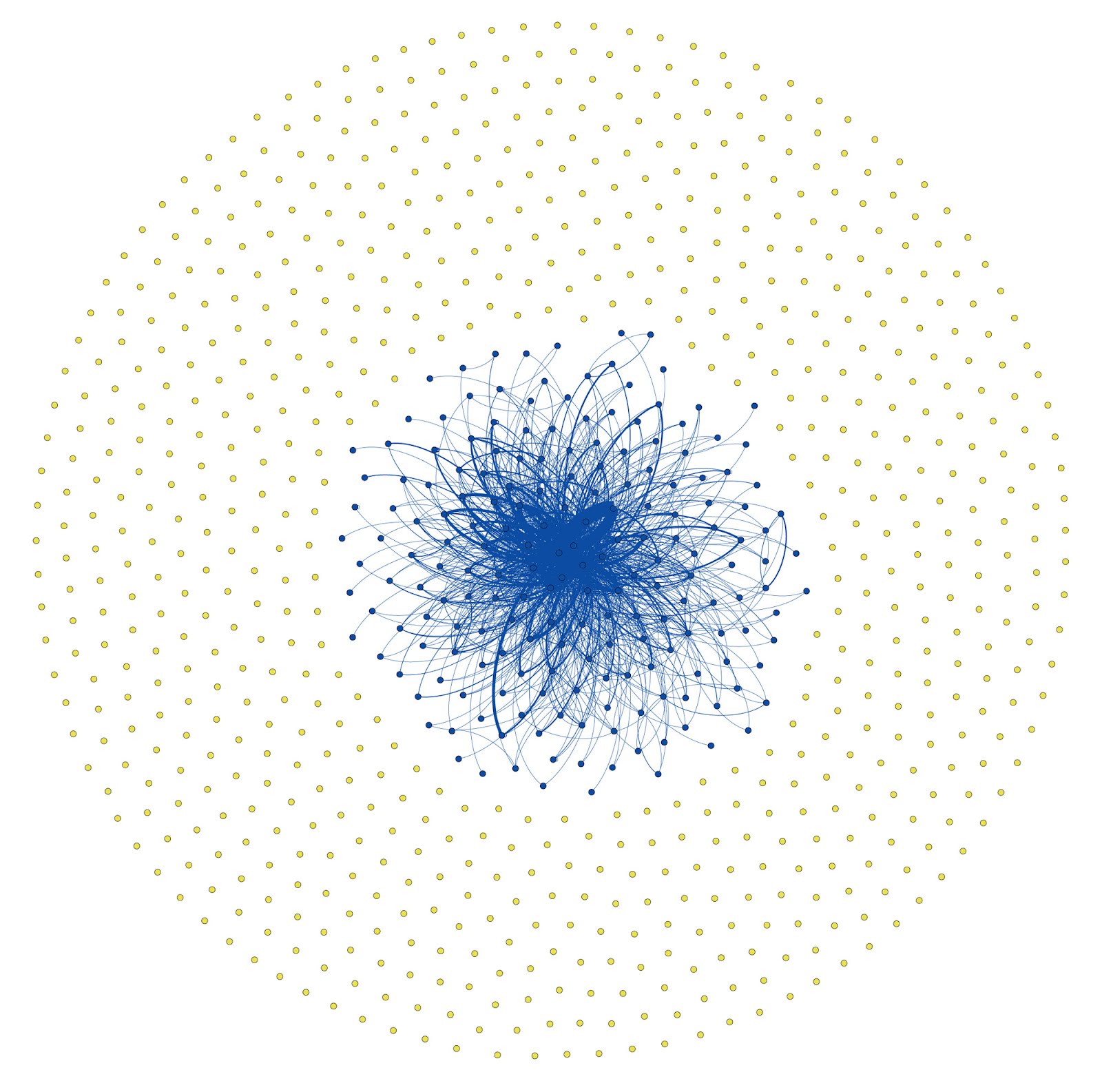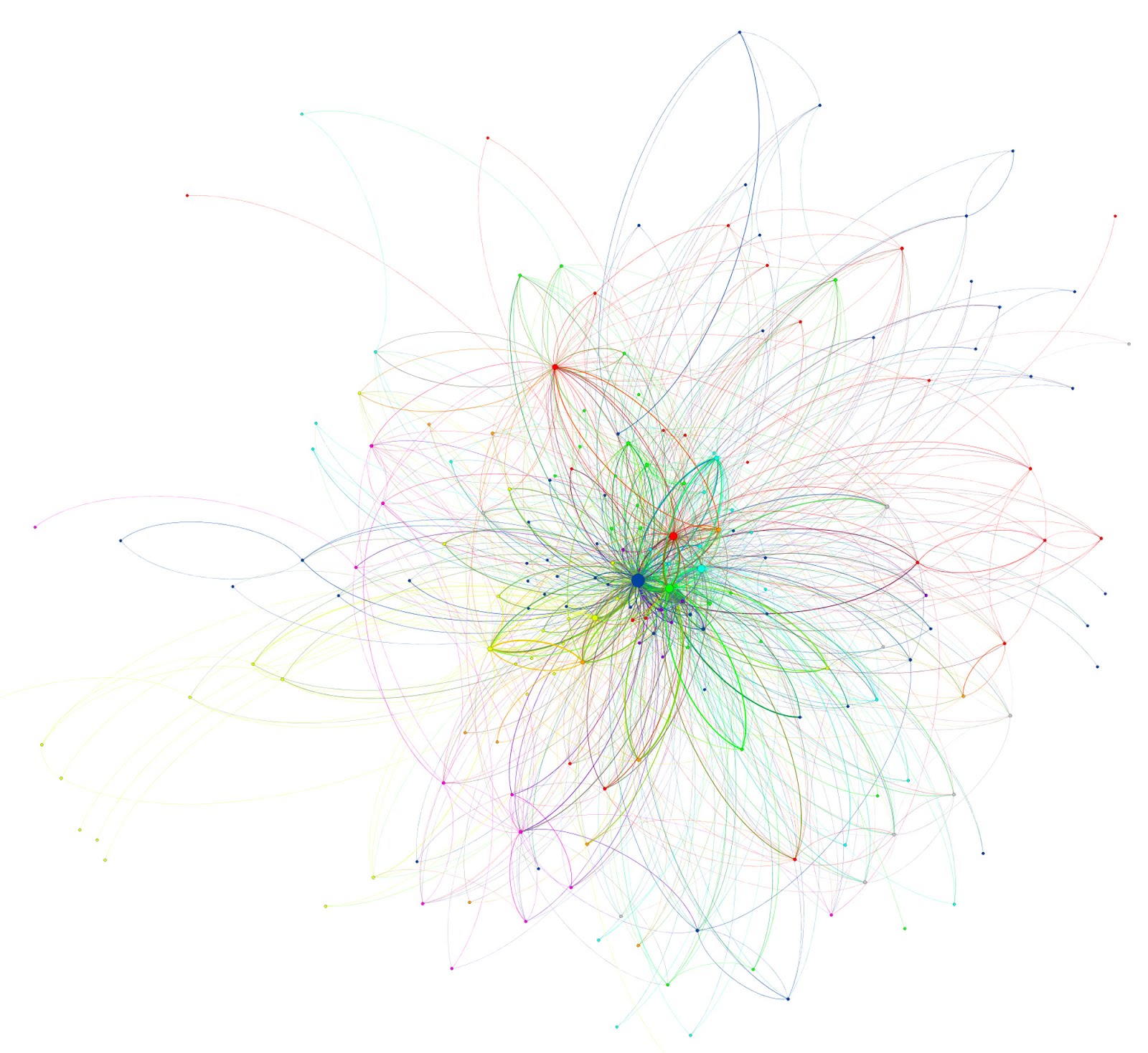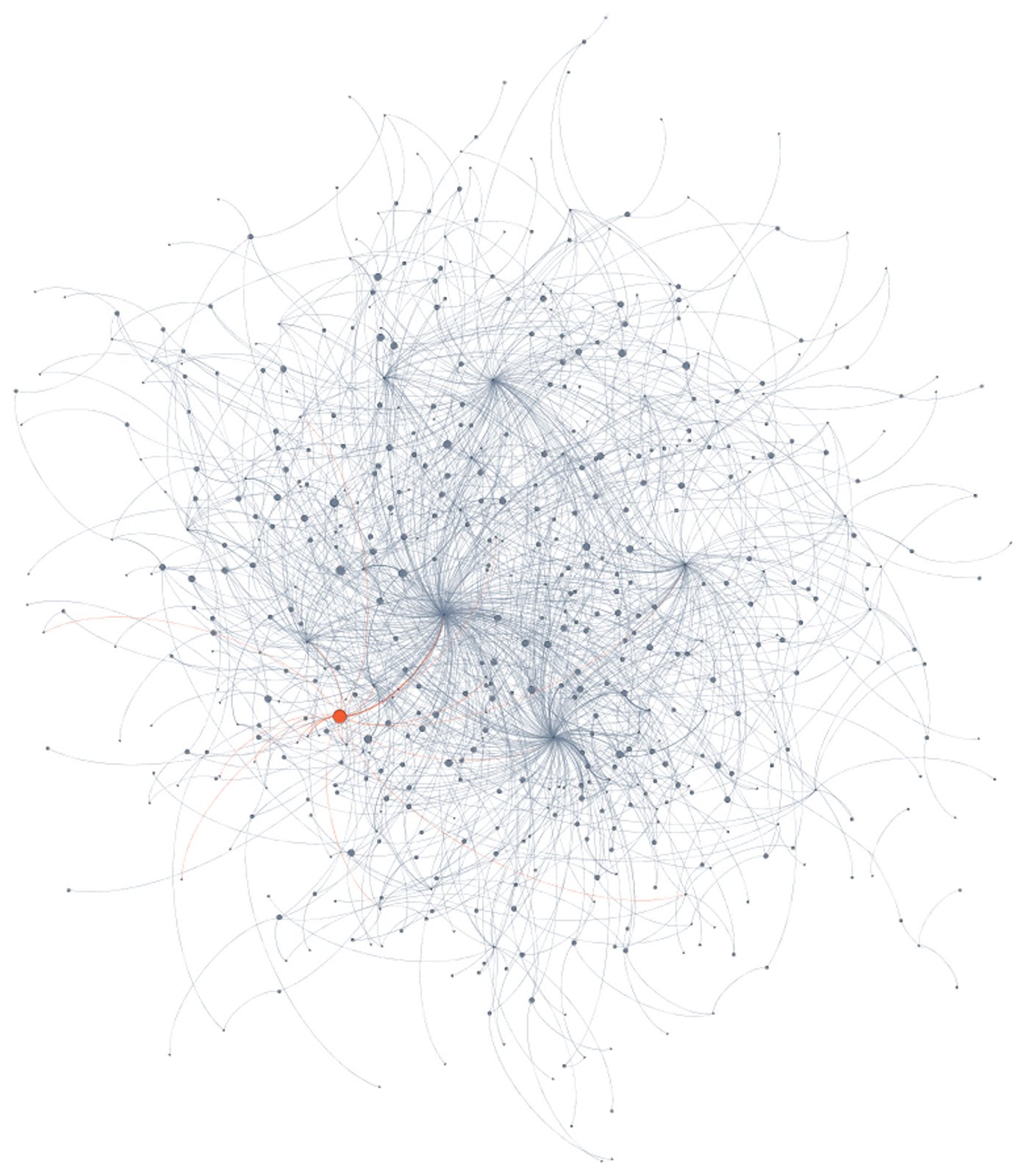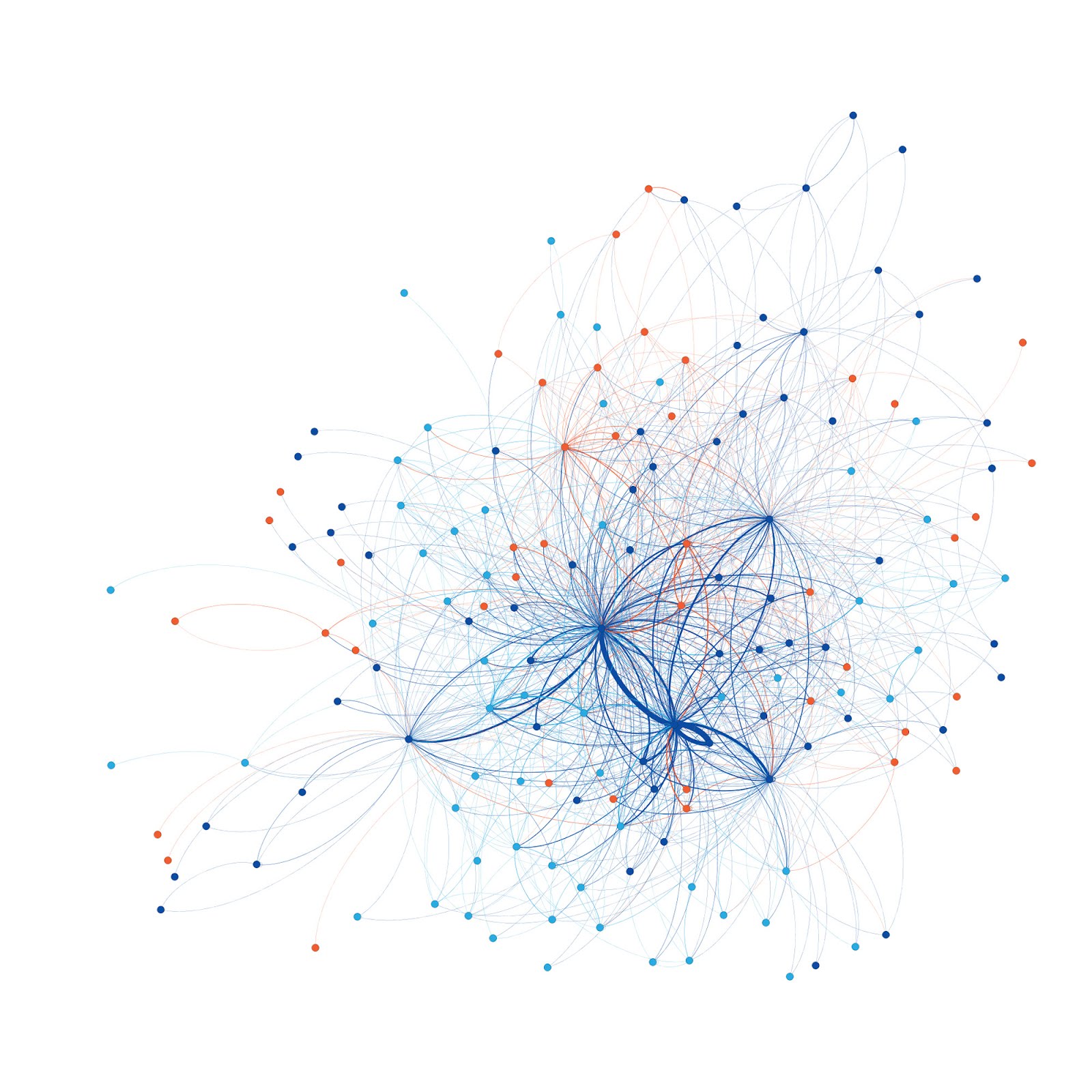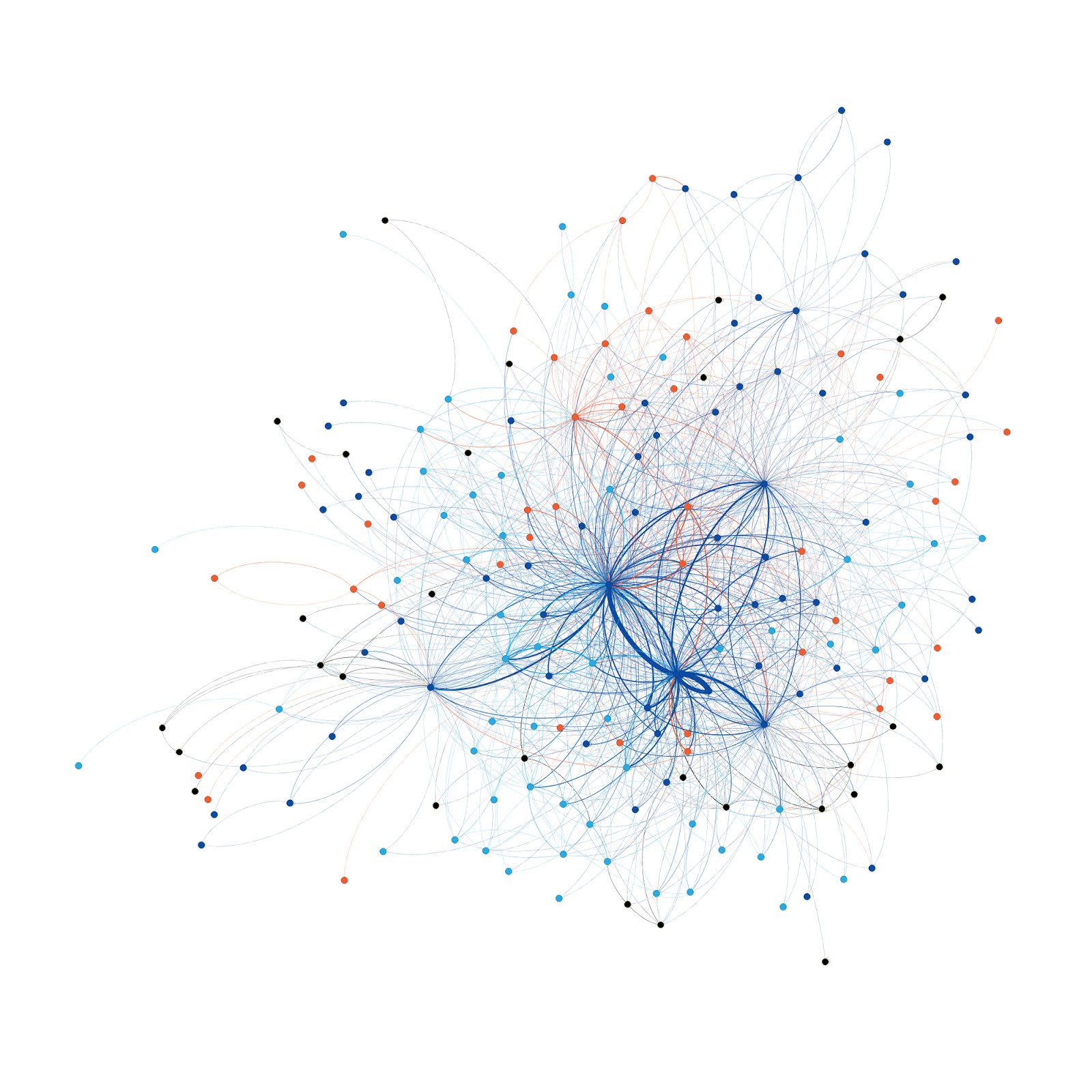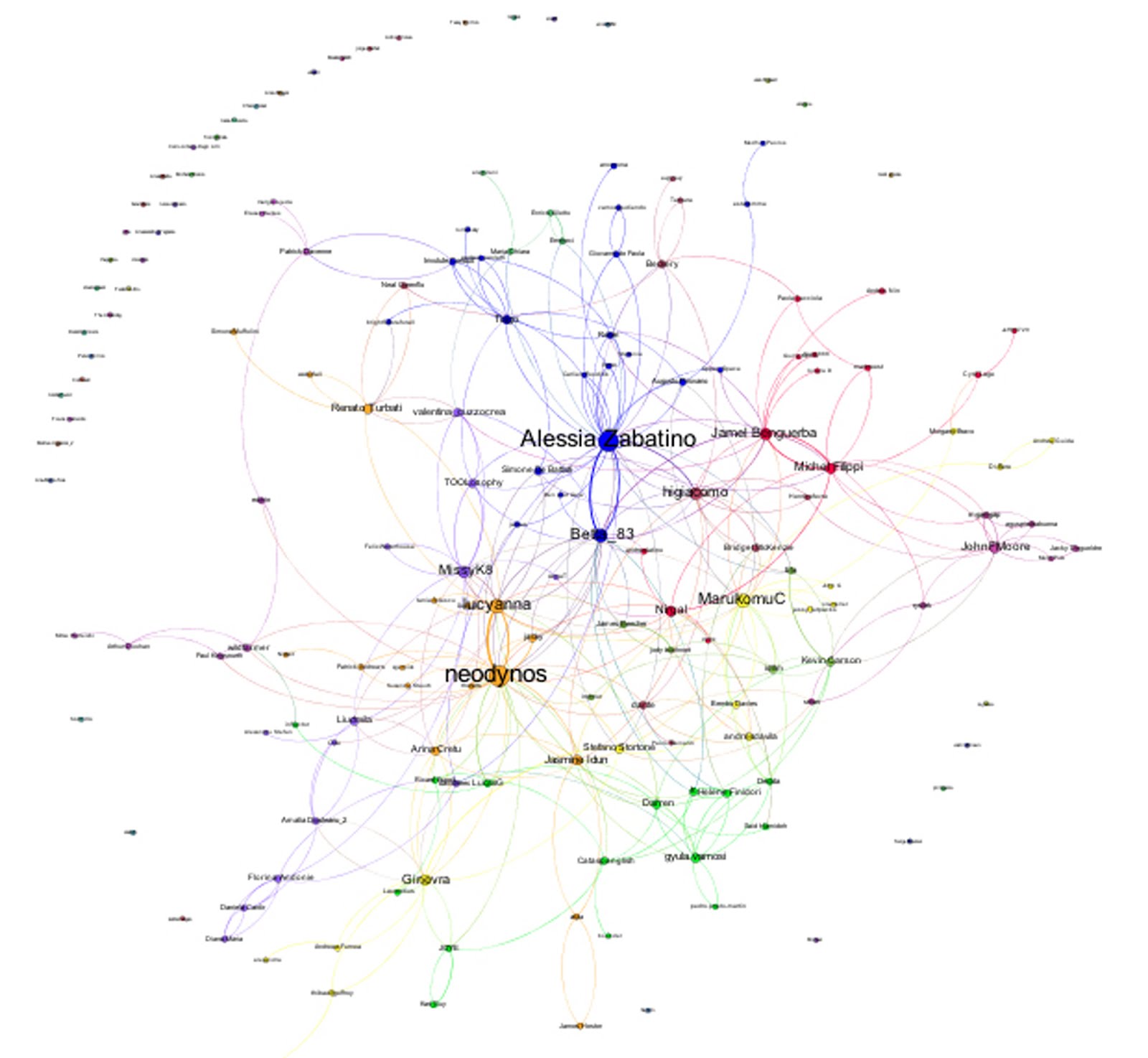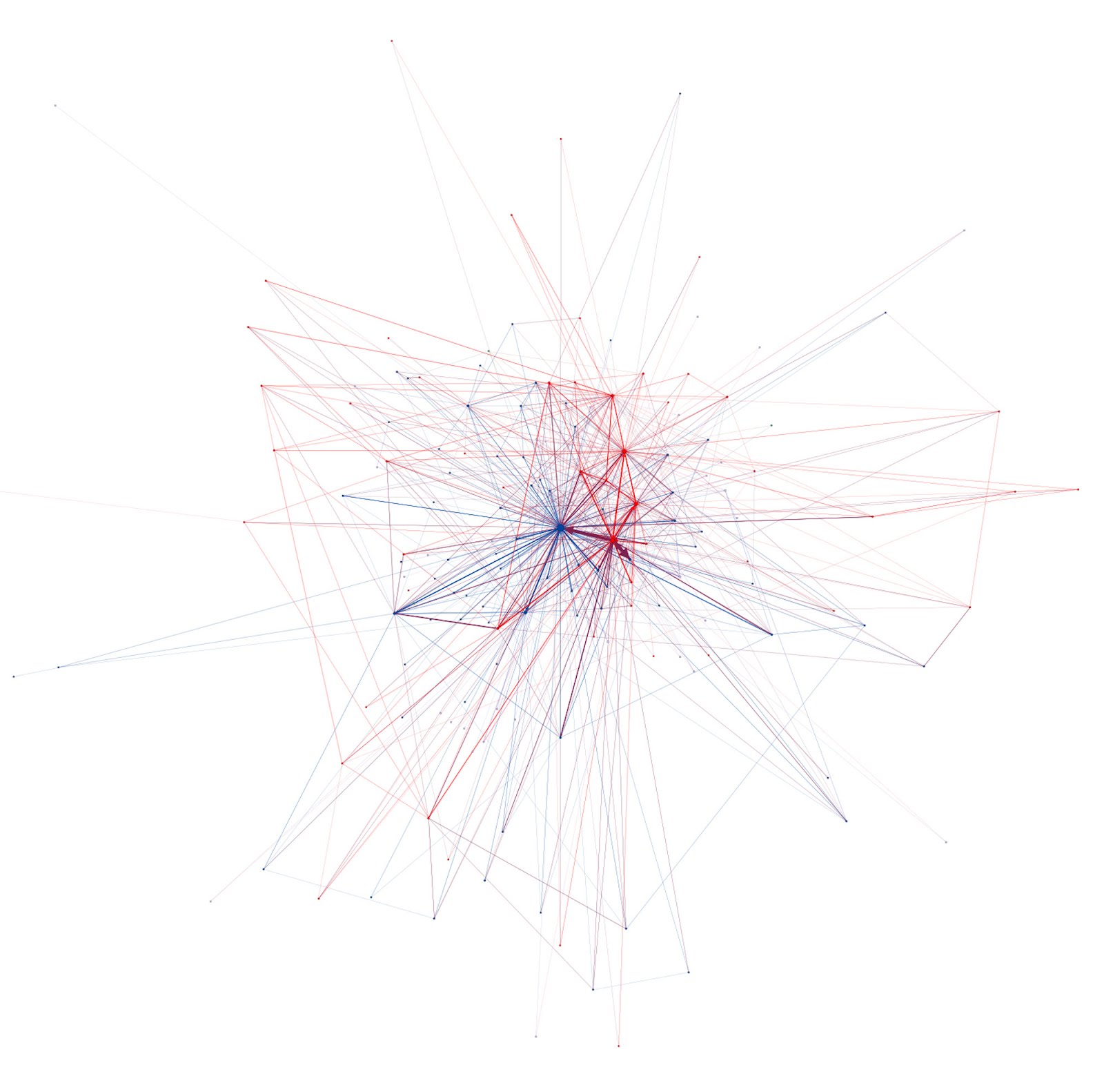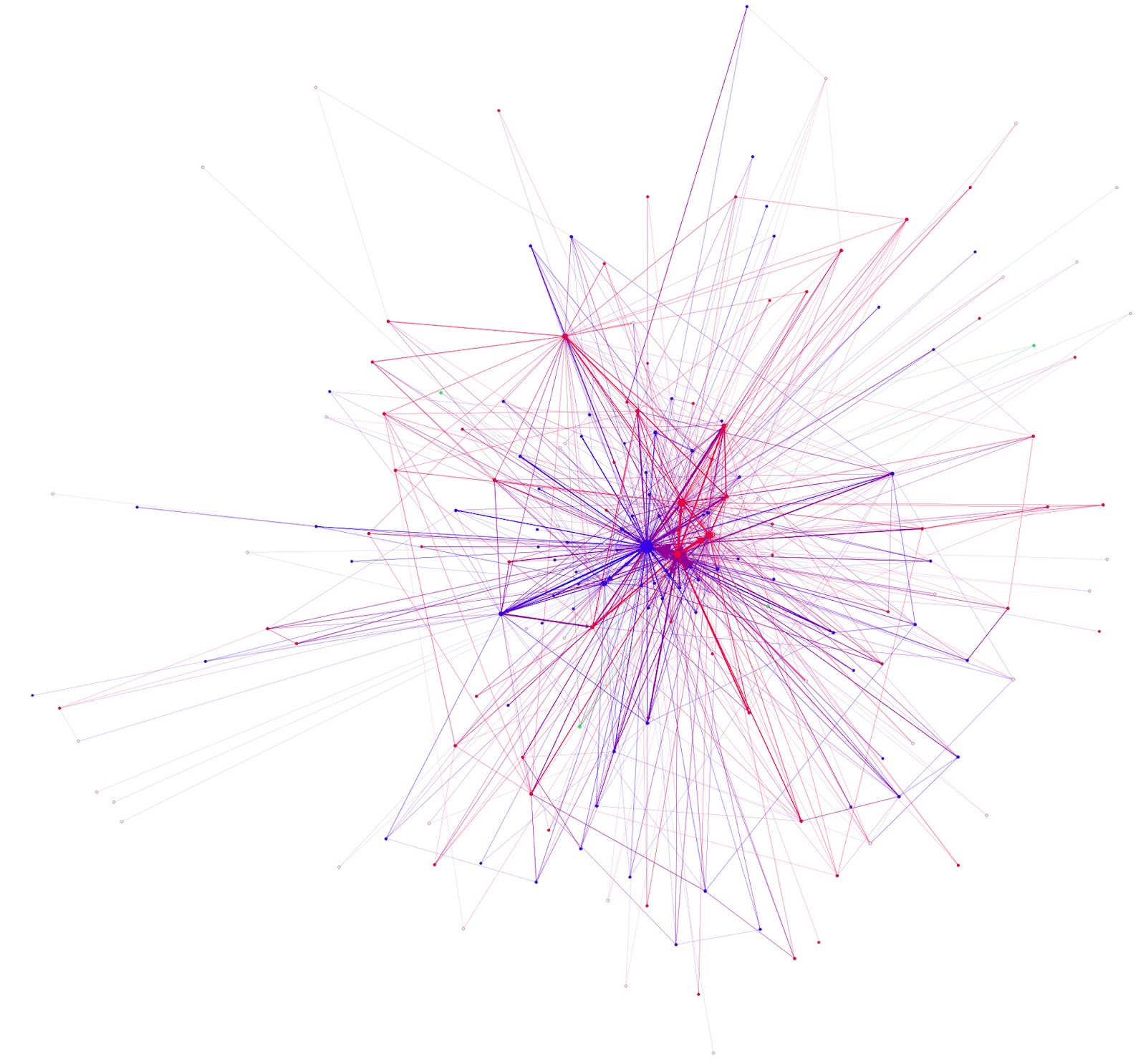.GET (“Arresting opening sentence”) . In this report we detail an initial analysis of the network that evolved around the online ‘EdgeRyders’ platform, and discuss what our findings suggest for the platform and for the proper development of networks-aware public policy.
1. Introduction: A note on networks.
Networks are not a thing, they are a way of understanding and representing the world. A social networks perspective seeks to understand the way in which discrete units – nodes – are connected and affected by the relationships between them. In EdgeRyders our nodes are people and their outputs: individual edgeryders and their mission reports. The relationships that we measured and represented are the online discussions that originated around the mission reports. Thus the networks we highlighted are networks of shared interest and inquiry.
1.1 Networked Ryders?
EdgeRyders is unique in being an online platform in which individuals speak from personal experience to a dual audience of peers and policy makers. The networks we analysed arise in the conversations around these individual experiences, via the process of writing a mission report - a personal account of ideas, experience or knowledge - grouped under specific campaigns. Each personal account expressed on the platform aspires to be useful to other users and peers; whilst overall the platform seeks to render ideas, experience and projects in such a way as to make them accessible to policy makers.
We sought to understand who was using the EdgeRyders platform, the ways in which they were connected to each other, the ways in which these connections evolved and came about, and what this means for the proper evolution of the Edgeryders project. Beyond analysing and visualising the EdgeRyders networks that we had access to, our enquiry was structured around three main questions
- What should the structure of a crowd-sourced think tank be?
- Can network analysis be used to help the growth of the network, and if so, how?
- How does EdgeRyders fit into the concept of opendata and open democracy?
EdgeRyder members have frequently signalled desires for opendata, greater transparency and open participation in the way processes of governance are structured. Whilst publicly available, the data analysed in this report is by no means ‘open’: in its aggregate form it is only currently available to the research team. We address this in our recommendations, focusing on how this data may be made available in a useful way to others; whilst questioning what open network analysis could become in this context.
2 Methodology
We used a combination of network analysis and qualitative methodologies. We analysed written content on the platform and used open-ended interviews and ethnographic research before and during the EdgeRyders conference to understand the motivations behind usage of the platform and the project more generally.
At the time of the main body analysis - early June 2012 - 80% of registered users were inactive. As such, our network analysis details the communication between the 20% of users who were active. We used a combination of data that was extracted directly from the EdgeRyders website, and manual data collection.
That which could be directly extracted from the platform at the time of analysis included a list of all users, directional interactions between users, the amount of interaction between individuals and the frequency of interaction between users and specific mission reports. Whereas extracted data was complete, the additional attribute data that was manually collected from the website was only present where users elected to give us such information. As such, information about gender, locality and totem-animal preference# is incomplete. The networks have been analysed at four time-points. These have been used to illustrate structural evolution of trends in each instance.
On the whole, we used open-source software for our analysis including: Open Office Calc (free to use open-source Excel equivalent) for cleaning datasets and Gephi (free to use open-source network analysis tool) to analyse and visualise the data provided.
3. The EdgeRyders Social Network
In this section we analyse: the overall structure of the EdgeRyders network, the way in which this structure evolved over time, factors that affect the network structure, and social networks external to the EdgeRyders platform.
Key Findings
- Beware the lurkers: as of the 4th June 2012 the network comprised 913 users, of which 194 were actively participating by posting reports and commenting on other user reports, whilst 719 remained observers
- 60% of users are male and 40% are female (*where given)
- EdgeRyders come from 20 different countries (*where given)
- The ‘top’ three countries are: UK, Italy and France (*where given)
- Edgeryders who live in multiple cities throughout Europe outnumber those who claim to reside in a single city
- The network shows signs of moving from being community manager-led to being community-member led.
There are many ways to understand what a network should look like, all of which are contested. For the purposes of this analysis, we will be utilising the following concepts: i) Network Weaving and the four stages of community networks (Krebs and Holley); ii) the way in which information travels through bridges; iii) the action-spurring effects of dense networks and the ways these lead to the reinforcement of social norms (for ii) and iii) see R.Burt, 2000 For iii) note that since Durkheim, it has been held that dense networks lead to less social norm violations. Coleman (1990) is the most cited contemporary thinker to have proved this. There is a nice discussion by Portés in Portés, A, 1998, SOCIAL CAPITAL: Its Origins and Applications in Modern Sociology, Annual Review of Sociology. 24:1–24. Online. [Accessed May 2012].
One way of understanding the development of community networks is to so see their evolution in terms of going from scattered fragments, through to a hub-spoke shape into core periphery models (for offline networks see Krebs and Holley, 2006). What we suggest is that an effective network that covers many communities of interests and wide ranging geographical communities should have an overall core periphery structure, that can be shown to be composed of many small core periphery communities.
This vision of interconnecting core-periphery structures is one that could be a natural progression of how EdgeRyders has developed so far. To start with EdgeRyders was a series of scattered fragments with community managers who acted as hubs: the community managers were charged with weaving connections and the invitation of users with specific communities of interest meant that groupings emerged from the offset. With the progression of the project the structure become very core periphery, with highly connected community managers acting as the core of the network, and in the run-up to the Conference the structure became more complex, with far more inter-community member interaction. The question now is: what next?
Some quick network concepts:
Hub-Spoke is a network formation that visually resembles a chariot wheel, the hub acting as a centralised node that connects with a series of other nodes by spokes or ties; within the EdgeRyders network this is easily recognised with Mission Reports as the hub node and those commenting acting as the spoke nodes.
(See Krebs and Holley 200)
Core-Periphery is a simplified way of understanding to the extent to which a social network is centralised or decentralized. A network with high core-periphery will have a greater number of clustered communities located at the edges of the core network, referred to in this report as sub-communities.
Bridges are a type of social tie that connects two different groups in a social network, that may not otherwise be connected. In the EdgeRyder’s networks that we have analysed both Mission Reports and Individuals that could be seen as being network bridges.
(See R. Burt 2000)
Density can be read in the number of relationships or ties between nodes in proportion to the number of theoretically-possible relations or ties. Dense networks have significantly higher direct ties between all members.
(See discussion in Portes 1998)
3.1 What does the network look like?
Above is a birdseye view of the whole of the EdgeRyders community. With 913 registered users as of the 4th June 2012, the 194 active participants are shown clustered densely in the center, as indicated in blue; the inactive users are shown circulating the perimeter of the network, as indicated in yellow.
In our analysis we analysed two types of networks: edgeryder-to-edgeryder networks and edgeryder-to-post networks:
Ederyder-to-edgeryder networks: that network which emerges when you take account of comments between EdgeRyder members on the same mission report. If edgeryder Ann comments on edgeryder Bob’s mission report, then a directed tie is created from Ann to Bob. If Bob responds to Ann’s comment, a tie is created from Bob to Ann.
Edgeryder-to-post network: that network which arises when you take account of which edgeryder commented on which report. In the above example, a tie is created between Ann and Bob’s report ‘of mice and edgeryders’; and between Bob and Bob’s report ‘of mice and edgeryders’.
Analysing edgeryder to edgeryder networks
Before the conference, the EdgeRyders network seemed dominated by EdgeRyders staff, although with clear indications that certain community members were beginning to take on a community weaving role. They were not changing the overall shape of the network, but communication between community members was clearly intensifying rapidly.
To start understanding the shape of the overall network, we looked at its various stages of evolution at different time-points, detected those nodes with the most connections, did research to understand why the nodes were so connected, visualised the overall network using a force atlas algorithm and used modularity to start detecting sub-communities. These two algorithms work in tandem: force-atlas places the nodes in the sociogram as a function of who they are connected to, and modularity can be used to understand how strongly a network divides into ‘modules’: groups, clusters or sub-communities.
Using various iterations of modularity measures, we identified the emergence of 7 weakly bound sub-communities in which the key nodes - the individuals central to each of these sub-communities - were EdgeRyders staff who were tasked with the role of community managers: Alberto, Hexayurt, Nadia, Chara, Lyne, Noemi and Albertomz. We found that these individuals accounted for the majority of comments left on the platform, but that there was evidence that their role was in flux, with new non-community manager nodes emerging as weavers. Indeed, in the last time-slice we analysed it seemed clear that the community was diversifying into further sub-groupings that went beyond the paid community managers.
Mission Report Network
The analysis of the ties between EdgeRyder members and specific mission reports were less centralised and less reliant on EdgeRyders staff, showing that frequency of interaction between users doesn’t directly correlate with the formation of sub-communities of shared inquiry. The Mission Reports network highlights the direct relationship between individuals and reports showing how communities and connections are forged around specific content uploaded to the network.
Mission Reports here are coloured orange, whilst all ties and edgeryder nodes are depicted in blue. Mission reports have been sized according to the number of comments made, to show the distribution of conversation between reports.
Here we isolated a single Mission Report; the visualisation shows the spread of the Mission Report through the network, as indicated in orange - orange ties indicate edgeryder’s comments on the report. The report mapped is ‘PRACTICAL RESILIENCE: EUROPE IS AT RISK OF WAR - WHAT SHOULD WE DO?’ and is a good example of how single reports can contribute to the diversification of the network as they are able to reach across multiple sub-communities leading to a increased exposure to other users and strengthened ties between edgeryders.
This Mission Report is of interest in considering how the platform is able to draw in new users; new users joined exclusively to be part of the discussion generated by this report and this was as a direct result of the report’s circulation through Twitter. Page view numbers seem to show that reports circulated through mediums external to EdgeRyders receive a greater audience than would be possible solely within EdgeRyders.
Evolution
In order to understand how the network has evolved from its inception up until June 2012, the database has been extracted on 4 separate occasions. The time-slices are dated early February 2012, early April 2012, late April 2012, and early June 2012.
To date, the community has grown through a snowball effect: growth happens when community members and managers invite their friends, contacts and communities of interest to join. At this stage in the analysis, it appears that we can talk about one and a half ‘snowball waves’, and about the effect of different communities of interest having been invited onto the platform. For example some of the earliest EdgeRyders were John F Moore, founder of the open government organisation ‘The Lab’, and other open government proponents. By the last time slice we analysed, we start to see that the primary driving force in the growth of the platform is through recommendations to friends to join- the network starts to look like it’s on its way from hub-spoke to core-periphery!
The emphasis on peer-to-peer invitations is a potentially positive way of fomenting the formation of networks: if individuals continue to invite those they are already connected with, it will ensure pre-existing networks and conversations are brought online, which benefits the platform. However, to avoid the EdgeRyders platform exacerbating existing cliques - or filter bubbles - this form of network growth requires a greater focus on diverse network weaving by community managers and/or the introduction of new functionality.
The nodes for time-slice 1 are indicated in blue - extracted February 2012
The nodes for time-slice 2 are indicated in orange - extracted beginning April 2012
The nodes for time-slice 3 are indicated in aqua blue - extracted end April 2012
The nodes for time-slice 4 are indicated in black - extracted beginning June 2012
What affects structure?
1. The relationship between individual and institution
As indicated in our initial overview of the network, those employed through EdgeRyders to community-manage occupy important positions in the network; in order to better understand the evolution of the network we have to sought to interrogate the effect of the institution upon the network. It is logical that those employed by the Council of Europe have been most active so far in the network, since there is an obligation to commit a more substantial amount of time. We have also examined how community managers have been encouraged to engage with EdgeRyder members to ensure continued interaction and aggregation of content.
This type of community management - understood here as an example of network weaving - has increased the density of the network; it has been common practice for community managers to connect users with shared interests and overlapping lines of enquiry. The success of those community managers in forging new connections is shown by how community-member-only networks become exponentially more dense over time, with less of a reliance on the initial network hub/core of community managers. This can be substantiated and better illustrated by removing community managers from the network and comparing time-slices 3 and 4.
The way in which individuals’ characteristics affect the network
Where given the gender-balance on EdgeRyders was 40% women and 60% men, with 4 organisations redacted. In these visualisations women are pink, men are blue.
Communication between the sexes in the initial phase of the platform, as shown in time slices 1 and 2, was found to be disproportionately restricted to same sex dialogue. This is indicated in the visualisations by the width of ties; which are sized according to EdgeWeight - number of comments-; the directional flow is illustrated by arrows.
When we get to time slice 3 this negative trend has begun to correct itself, with time slice 4 we see that a healthy balance of intergendered interaction has emerged throughout the network. We also found that, on average, women have written on a wider range of mission reports than men.
Beyond the Platform
EdgeRyder members are not just connected on the EdgeRyders platform: it is clear that communication outside of the website is playing a pivotal role in influencing the structure and growth of the community. No one has yet analysed the full effect of the lote conference but inevitably the acceleration of face to face interaction has increased online and offline activity.
Online
Twitter: has played a major role in communication between users. This is not all that surprising given the type of individual likely to be attracted to a networked online platform such as Edgeryders, but the enduring nature of the conversations on twitter are worthy of note. The hashtags lote and #EDGECAMP were used to facilitate fast moving conversation during the EdgeRyders conference and unconference. The conversations around these hashtags led to new twitter relationships between EdgeRyders members and between EdgeRyder members and non-EdgeRyder members. The discussions started during the conference are still active, albeit with a more reduced following, and are being used in some instances to build up to offline post-conference meet-ups.
Facebook: doesn’t seem to have played such a significant role as Twitter. The lack of visible connections could be in part due to the privacy settings inherent in Facebook’s interface. We have however observed the creation of Facebook groups for discussion and this is likely to lead to a greater number of connections being made.
Offline
Pre-existing Networks: in the comments thread of our initial report and in conversation with edgeryders we asked the question Who did you already know on EdgeRyders before joining the platform? and Who from your pre-existing networks have you invited to join the platform?. Without clear quantitative data it is difficult to establish the exact impact of these offline networks on the platform, but the snowball effect indicated in the evolving structure of the network would indicate that this is playing a fundamental role in its development.
Future network analysis of the community should seek to better understand the relationship between online and offline networks, to ensure a full picture of the networks growth.
Meetups: breakout sessions staged at EdgeCamp led to the creation of Europe wide group meetups, operated through meetup.com, in a number of capital cities. The intention is to use these offline meetings to carry forward the momentum generated during the conference.
We have put together a series of visualisations to illustrate these new clusters – as a first step towards understanding the relationship between online/offline networks and the convergence of the two.
These developments could mark a significant shift for the network: from a knowledge discovery exercise, in which users express their personal experiences on the platform in relative isolation to a knowledge creation exercise in which users increasingly meet on and offline to work together.
At what point does the EdgeRyders community network end and other online and offline networks begin? As activity increasingly takes place away from the website - on Twitter, Meetups and Facebook - it’s important to take a decision about how these networks should be analysed, or if they should in fact be analysed at all. Autonomy has been an important theme throughout EdgeRyder’s mission reports, and any attempt to analyse, collate or extract this data should be highly sensitive to these values.
Conclusion
What should the structure of a crowd-sourced think tank be? The platform is currently displaying emergent structural trends that could indicate healthy growth. However, it is essential that we return to the question of the ideal structure for what is ostensibly a crowdsourcing research exercise,
The trend towards a denser and more diverse core-periphery structure would suggest that the network is becoming more resilient and will become less reliant on community managers. If the network continues to grow in this way, a fundamental question of sustainability should be asked; current functionality is limited in not giving enough visibility and navigation for users to easily establish their own relationships with other users - connections and awareness are generated primarily through community managers. This is a problem: if EdgeRyders were to experience a sudden spike in its user base, the infrastructure for managing the community would fall over - both in terms of technical functionality and in community management strategies.
This signals the need for a critical decision to be taken in supporting the continued growth of the platform, with two routes that can be adopted, exclusively or in parallel, with divergent effects, those are; the introduction of new functionality that allows users to better find and make connections themselves, thus further decentralising the network through a self generative effect, or alternatively the introduction of more community managers tasked explicitly with the role of network weaving and supporting the formation of sub-communities, leading to a distributed but organisationally centralised network.
The network analysis conducted here should be used to support and inform any allocation of resources in either one of these directions; going forward, continued analysis will be required to ensure maximised use value for the content generated. To this end we suggest the adoption of a monthly cycle of data extraction with continued public analysis.
Recommendations
- Teach EdgeRyders to Network Weave
- Analyse other online and offline networks
- Monthly Data Extraction and Public Network Analysis
- Promote the platform as a successful model for Open Democracy
Platform Functionality Recommendations
- Introduce a user tagging system
With this in mind the landing page for logged in users should be focused on the way in which others are interacting with you.
- Embed and Integrate other networks into the platform
- Introduce mandatory attribute data fields


